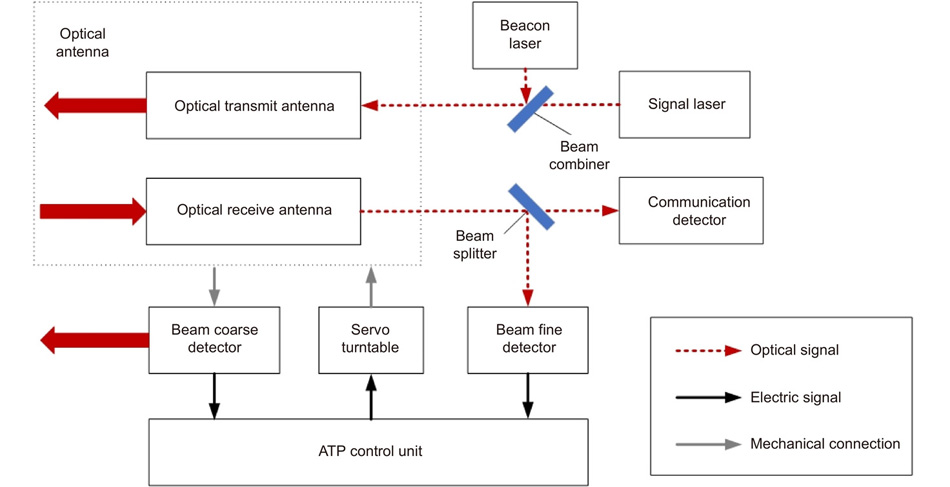Jingyuan Liang, Ruidong Chen, Haifeng Yao, Bo Bai, Minghua Cao, Li Zhao, Yi Wang, Jiaxin Deng. Research progress of acquisition, pointing and tracking in optical wireless communication system[J]. Opto-Electronic Engineering, 2022, 49(8): 210439
Search by keywords or author
- Opto-Electronic Engineering
- Vol. 49, Issue 8, 210439 (2022)
![Optical wireless communication APT system diagram[5]](/richHtml/gdgc/2022/49/8/210439/2_210439-1.jpg)
Fig. 1. Optical wireless communication APT system diagram[5]
![Typical wireless laser communication APT system diagram[1]](/richHtml/gdgc/2022/49/8/210439/2_210439-2.jpg)
Fig. 2. Typical wireless laser communication APT system diagram[1]
Fig. 3. Schematic diagram of experimental azimuth[33]
Fig. 5. Suppress the error before and after the angle increment[43]. (a) Angle increment before error suppression; (b) Angle increment after error supperssion
Fig. 6. Alignment response curve[43]
Fig. 7. The relationship between input voltage and angle[43]. (a) Control voltage and angle in θx direction; (b) Control voltage and angle in θz direction
Fig. 8. Structure of beam detection system[5]
Fig. 9. Four kinds of situations of light beam detection[5]. (a) α=0, p=0; (b) α≠0, p=0; (c) α=0, p≠0; (d) α≠0, p≠0
Fig. 10. Transceiver integrated UAV relay APT system[45]
Fig. 11. The signal waveform of the oscilloscope at the receiving[45]
Fig. 12. Coordinate position distribution of spot center[45]
Fig. 13. 1.3 km far-field experimental system assembly structure diagram[5]
Fig. 14. Spot position coordinates (2016-05-25 22:46~2016-05-26 22:00, rainy, 13 ℃~18 ℃)[5]. (a) Azimuth direction; (b) Pitching direction
Fig. 15. Schematic diagram of beam tracking system[47]
Fig. 16. Tracking curve of beam (2017-12-05 18:00~2017-12-06 6:00, cloudy, −1 ℃~9 ℃)[47](a) Azimuth direction; (b) Pitching direction
Fig. 17. Statistical results of maintaining the beam position (2017-12-05 18:00~2017-12-06 6:00, cloudy, −1°~9°)[47] (a) Azimuth direction; (b) Pitching direction
Fig. 18. Assembly drawing of beacon free optical APT system of 10.2 km experiment[43]
Fig. 19. Spot center coordinates curve (2018-09-30 21:00~2018-10-01 0:00, sunny, 17 ℃)[48]. (a) Azimuth direction; (b) Pitching direction
Fig. 20. Spot center coordinates curve (2018.10.1 21:00~2018.10.2. 0:00, cloudy, 12 ℃)[48]. (a) Azimuth direction; (b) Pitching direction
Fig. 21. Spot center coordinates curve (2018-10-02 21:00~2018-10-02 0:00, cloudy, 14 ℃)[48]. (a) Azimuth direction; (b) Pitching direction
Fig. 22. Spot center fitting curve[48].(a) Change curve of spot center position; (b) Temperature and humidity curve
Fig. 23. 100 km field experiment scene[48]. (a) Receiving terminal; (b) Transmitting terminal
Fig. 24. Spot center coordinate change curve (The first experiment)[48]. (a) Spot center coordinates in horizontal direction; (b) Spot center coordinates in pitch direction (2019-08-18 23:00~2019-08-19 02:00, sunny, 14 ℃)
Fig. 25. Spot center coordinate change curve (The second experiment)[48]. (a) Spot center coordinates in horizontal; (b) Spot center coordinates in pitch direction (2019-08-20 23:00~2019-08-20 02: 00, cloudy and rainy, 9 ℃)
Fig. 26. Wireless optical communication IM/DD system with fast alignment of two-dimensional mirror[40]
Fig. 27. Experiment of wireless optical communication for 10.3 km[40]
Fig. 28. Beam tracing curve (2021-07-24 23:00~2021-07-25 6:00)[40]. (a) Pitching direction; (b) Azimuth direction
Fig. 29. Power spectrum density estimate[40]. (a) X position; (b) Y position
Fig. 30. Spot tracking curve and PSD[40]. (a) Curve of the beam tracking; (b) Curve of the beam tracking in X and Y directions; (c) X PSD; (d) Y PSD
Fig. 31. Receive and transmit signal waveforms[40]. (a) Transmitting signal; (b) Receiving signal
|
Table 1. Research progress abroad
|
Table 2. Domestic research progress
|
Table 3. Capture uncertain region to solve the experimental data record table[33]

Set citation alerts for the article
Please enter your email address



